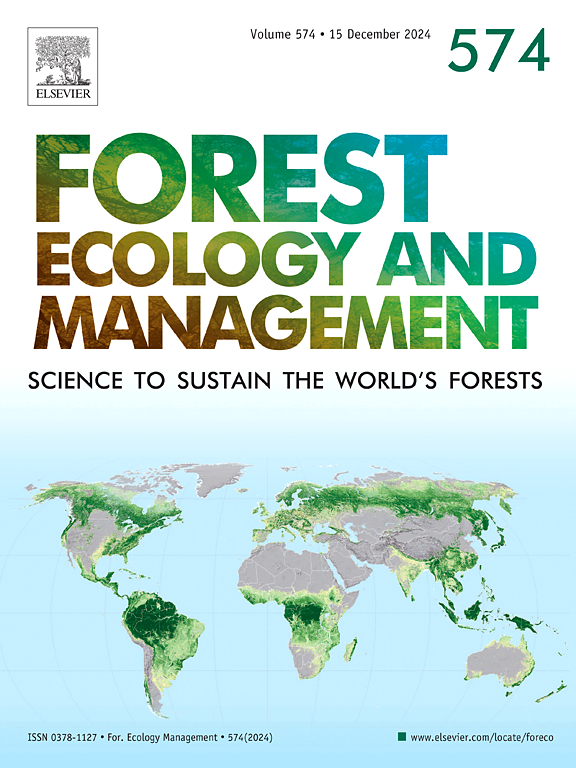One size does not fit all: Intra– and interspecific variation of den site use in two marsupial glider species in fragmented forest
IF 3.7
2区 农林科学
Q1 FORESTRY
引用次数: 0
Abstract
Habitat fragmentation poses challenges to arboreal mammals relying on tree hollows for denning. Knowledge of species-specific den preferences is needed to realise the full potential of restoration actions. Current advice regarding artificial den design is often highly rigid and specific, where there may be intra- and interspecific variation in den use that is not considered. We investigated denning preferences of the Sugar Glider (Petaurus breviceps) and Squirrel Glider (Petaurus norfolcensis) in remnant forest reserves, exploring the use of natural hollows and nest boxes, and which attributes of the dens were predictive of use. We radio-tracked 15 Squirrel Gliders and seven Sugar Gliders to denning locations where den characteristics were assessed and compared to randomly selected hollows not known to be used within the home range of the radio-tracked gliders. The hollow entrance size was the only variable that predicted den use in both species. Contrary to expectations, nest boxes were used proportionally more than natural hollows. This highlights that nest boxes can be an effective temporary solution to provide interim den sites for gliders in degraded forest remnants. Also contrary to expectations, hollow height showed only a weak correlation with den use. Seasonal variation and individual behaviours may influence glider preferences, emphasizing the need for nuanced management strategies. Based on these findings, we recommend against a one-size-fits-all approach in the application of artificial hollows for the restoration of glider denning habitat, especially in terms of the aspect and entry height, so that intra- and interspecific variation in den use can be accommodated.
一刀切:两种有袋滑翔机物种在破碎森林中使用巢穴的种内和种间差异
栖息地破碎化给依赖树洞筑巢的树栖哺乳动物带来了挑战。要充分发挥恢复行动的潜力,就必须了解特定物种对巢穴的偏好。目前有关人工巢穴设计的建议往往非常刻板和具体,没有考虑到巢穴使用的种内和种间差异。我们调查了残余森林保护区中糖滑翔机(Petaurus breviceps)和松鼠滑翔机(Petaurus norfolcensis)的巢穴偏好,探索了天然洞穴和巢箱的使用情况,以及巢穴的哪些属性可预测其使用情况。我们用无线电追踪了15只松鼠滑翔机和7只糖滑翔机到巢穴地点,对巢穴特征进行了评估,并与随机选择的、在无线电追踪的滑翔机家园范围内不被使用的空洞进行了比较。空洞入口的大小是预测这两个物种使用巢穴的唯一变量。与预期相反,巢箱的使用比例要高于天然空洞。这表明,巢箱可以作为一种有效的临时解决方案,为滑翔机在退化的森林遗迹中提供临时巢穴。同样与预期相反的是,空洞的高度与巢穴的使用只有微弱的相关性。季节变化和个体行为可能会影响滑翔机的偏好,这就强调了细微管理策略的必要性。基于这些研究结果,我们建议在恢复滑翔机的巢穴栖息地时,不要采用一刀切的方法来应用人工空洞,尤其是要注意空洞的长宽和入口高度,这样才能适应巢穴使用的种内和种间差异。
本文章由计算机程序翻译,如有差异,请以英文原文为准。
求助全文
约1分钟内获得全文
求助全文
来源期刊

Forest Ecology and Management
农林科学-林学
CiteScore
7.50
自引率
10.80%
发文量
665
审稿时长
39 days
期刊介绍:
Forest Ecology and Management publishes scientific articles linking forest ecology with forest management, focusing on the application of biological, ecological and social knowledge to the management and conservation of plantations and natural forests. The scope of the journal includes all forest ecosystems of the world.
A peer-review process ensures the quality and international interest of the manuscripts accepted for publication. The journal encourages communication between scientists in disparate fields who share a common interest in ecology and forest management, bridging the gap between research workers and forest managers.
We encourage submission of papers that will have the strongest interest and value to the Journal''s international readership. Some key features of papers with strong interest include:
1. Clear connections between the ecology and management of forests;
2. Novel ideas or approaches to important challenges in forest ecology and management;
3. Studies that address a population of interest beyond the scale of single research sites, Three key points in the design of forest experiments, Forest Ecology and Management 255 (2008) 2022-2023);
4. Review Articles on timely, important topics. Authors are welcome to contact one of the editors to discuss the suitability of a potential review manuscript.
The Journal encourages proposals for special issues examining important areas of forest ecology and management. Potential guest editors should contact any of the Editors to begin discussions about topics, potential papers, and other details.
 求助内容:
求助内容: 应助结果提醒方式:
应助结果提醒方式:


